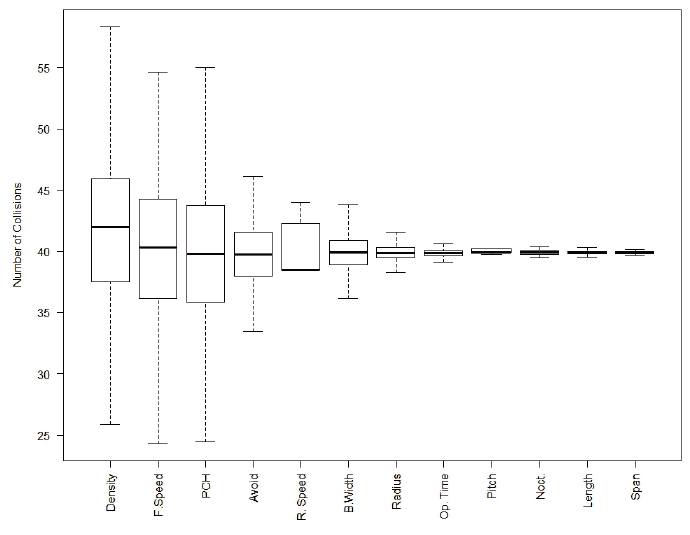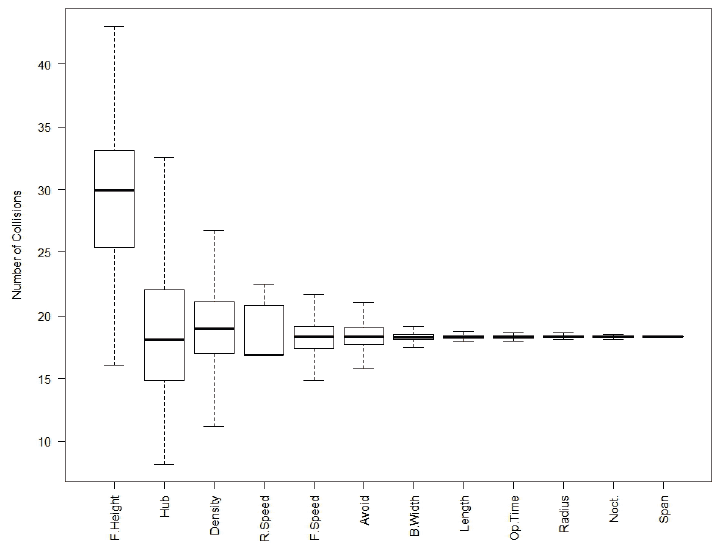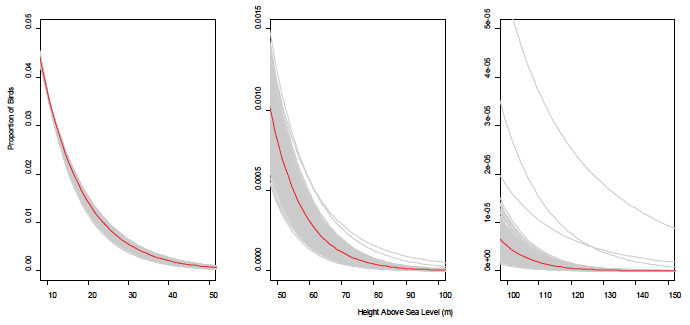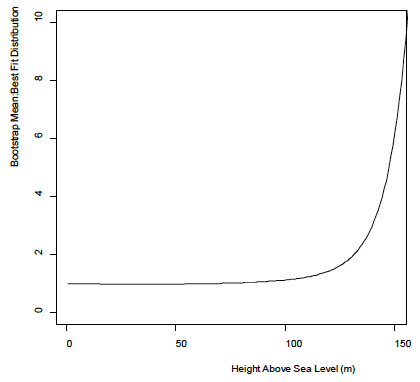Scottish Marine and Freshwater Science Vol 6 No 14: Developing an avian collision risk model to incorporate variability and uncertainty
The report describes the data required, and the methods used, to estimate collision
risk. It is accompanied by a worked example and R code (available at
http://dx.doi.org/10.7489/1657-1), which enables the collision risk calculations to be
performed in
Appendix 2: Sensitivity analyses
Chamberlain et al. (2006) previously documented that the Band model was sensitive to input parameters. Following on from this, the sensitivity of the Band model update produced during the SOSS project (Band 2012) was assessed, both for the basic and extended versions. Similar to Chamberlain et al. (2006), the effect of a 10% change in the input parameters was assessed but in addition, a more realistic parameter range was also assessed.
When assessing the effect of a 10% change in the flight height distribution for the extended model, we increased the proportions of birds at heights between the minimum and maximum rotor tip heights by 10%.
The following data sources were used for the input parameters. For turbine-related parameters, expert opinion within the project group was used to assess reasonable parameters ranges and those likely to be built out in the near future.
| Bird-related Parameter | Data description |
|---|---|
| Length | Taken from Concise Birds of the Western Palearctic (Cramp and Perrins, 1993) and other sources |
| Wingspan | Taken from Concise Birds of the Western Palearctic (Cramp and Perrins, 1993) and other sources |
| Flight speed | RSPB telemetry data (breeding season only) |
| Nocturnal activity | RSPB telemetry data (breeding season only) |
| Proportion at collision risk height | Generic flight height curve provided with the Band model and data provided by BTO (Johnston et al. 2014). |
| Flight height distributions | Data provided by BTO (Johnston et al. 2014). |
| Avoidance | 'All gulls' rate available from Marine Scotland Science avoidance report (Cook et al. 2014) |
| Bird density | Taken from Creyke Beck A Environmental Statement |
| Turbine-related Parameter | Description/Notes |
|---|---|
| Rotor radius | Expert opinion |
| Hub height | Expert opinion |
| Max. blade chord width | Expert opinion |
| Rotation speed | Expert opinion (example relationship between wind speed and rotation speed) |
| Blade pitch | Expert opinion (example relationship between wind speed and pitch) |
| Turbine operation time | Taken from Inch Cape Environmental Statement |
10% change
BASIC MODEL (Option 1)
| Input variable | Baseline | Baseline ± 10% (increases mortality) | Collision risk (in absence of avoidance) | Revised number of collisions | % increase in number of collisions |
|---|---|---|---|---|---|
| Avoidance rate | 0.9893 | 0.8904 | 0.065 | 439 | 921 |
| Non-avoidance rate | 0.0107 | 0.0118 | 0.065 | 47 | 9 |
| % at collision risk height | 6 | 6.6 | 0.065 | 47 | 9 |
| Bird density (birds/km 2) | 9.89 | 10.879 | 0.065 | 47 | 9 |
| Flight speed (m.s -1) | 7.26 | 7.986 | 0.063 | 46 | 7 |
| % nocturnal flight | 3.3 | 3.63 | 0.065 | 43 | 0 |
| Bird length (cm) | 39 | 42.9 | 0.067 | 44 | 2 |
| Wing span (cm) | 108 | 118.8 | 0.065 | 43 | 0 |
| Number of turbines | 100 | 110 | 0.056 | 47 | 9 |
| Rotor radius (m) | 80 | 88 | 0.061 | 44 | 2 |
| Hub height (m) | 125 | 112.5 | 0.065 | 43 | 0 |
| Rotation speed (rpm) | 7.74 | 8.514 | 0.067 | 44 | 2 |
| Blade width (m) | 5.5 | 6.05 | 0.069 | 46 | 7 |
| Blade pitch (degrees) | 0 | - | - | - | - |
| % time operational | 87.61 | 96.371 | 0.065 | 47 | 9 |
Effects of 10% variation in input parameters on predicted mortality rates of black-legged kittiwakes using hypothetical wind farm parameters (100 turbines). Original collision risk was 0.065 and the original number of predicted collisions per year was 43. Collisions are presented as integers.
EXTENDED MODEL (Option3)
| Input variable | Baseline | Baseline ± 10% (whichever increases mortality) | Collision risk (in absence of avoidance) | Revised number of collisions | % increase in number of collisions |
|---|---|---|---|---|---|
| Avoidance rate | 0.9672 | 0.8705 | 0.065 | 9 | 350 |
| Non-avoidance rate | 0.0328 | 0.0361 | 0.065 | 3 | 50 |
| % at collision risk height | 6 | 6.6 | 0.065 | 3 | 50 |
| Bird density (birds/km 2) | 9.89 | 10.879 | 0.065 | 3 | 50 |
| Flight speed (m.s -1) | 7.26 | 7.986 | 0.063 | 2 | 0 |
| % nocturnal flight | 3.3 | 3.63 | 0.065 | 2 | 0 |
| Bird length (cm) | 39 | 42.9 | 0.067 | 2 | 0 |
| Wing span (cm) | 108 | 118.8 | 0.065 | 2 | 0 |
| Number of turbines | 100 | 110 | 0.065 | 3 | 50 |
| Rotor radius (m) | 80 | 88 | 0.061 | 5 | 150 |
| Hub height (m) | 125 | 112.5 | 0.065 | 8 | 300 |
| Rotation speed (rpm) | 7.74 | 8.514 | 0.067 | 2 | 0 |
| Blade width (m) | 5.5 | 6.05 | 0.069 | 2 | 0 |
| Blade pitch (degrees) | 0 | - | - | - | - |
| % time operational | 87.61 | 96.371 | 0.065 | 3 | 50 |
Effects of 10% variation in input parameters on predicted mortality rates of black-legged kittiwakes using the hypothetical wind farm parameters (100 turbines). The original collision risk was 0.065 and the original number of predicted collisions per year was 2. Collisions are presented as integers, therefore the % increase in the number of collisions is greatly influenced by rounding.
Real data range
BASIC MODEL (Option 1)
| Input variable | Input variability | Mean collisions ( SD) | Median collisions ( IQR) |
|---|---|---|---|
| Avoidance rate | N(0.9893,0.0007) | 39.76 (2.55) | 39.72 (3.61) |
| % at collision risk height | N(6, 0.9) | 39.77 (6.06) | 39.77 (7.86) |
| Bird density (birds/km 2) | tN(monthly mean, monthly SD) | 41.86 (6.40) | 41.99 (8.39) |
| Flight speed (m.s -1) | N(7.26, 1.50) | 40.25 (5.73) | 40.30 (8.09) |
| % nocturnal flight | N(3.3, 0.45) | 39.90 (0.19) | 39.91 (0.26) |
| Bird length (cm) | N(39, 0.5) | 39.89 (0.15) | 39.89 (0.21) |
| Wing span (cm) | N(108, 4) | 39.89 (0.09) | 39.89 (0.12) |
| Rotor radius (m) | N(80, 5) | 39.89 (0.67) | 39.84 (0.88) |
| Hub height (m) | Rotor radius + N(26.5, 2) | 39.89 (0) | 39.89 (0) |
| Rotation speed (rpm | Relationship to wind speed | 40.15 (1.81) | 38.51 (3.76) |
| Blade width (m) | N(5.5,0.3) | 39.91 (1.39) | 39.90 (1.97) |
| Blade pitch (degrees) | Relationship to wind speed | 40.50 (1.66) | 39.89 (0.32) |
| % time operational | Wind availability-tN(6.3, 2) | 39.91 (1.39) | 39.90 (1.97) |
Effects of variation in input parameters on predicted mortality rates of black-legged kittiwakes using the hypothetical wind farm parameters (100 turbines). 500 iterations. The original collision risk was 0.065 and the original number of predicted collisions per year was 40. N is normal distribution. N(mean, SD). tN is truncated normal distribution. Hub height does not affect calculations in option 1, therefore the values were constant across all iterations.

Effects of variation in input parameters on predicted collision mortality of black-legged kittiwakes using the basic Band model. Density values are slightly skewed due to need for use of truncated normal distribution as negative density values are not possible.
EXTENDED MODEL (Option3)
| Input variable | Input variability | Mean collisions ( SD) | Median collisions ( IQR) |
|---|---|---|---|
| Avoidance rate | N(0.9672, 0.0018) | 18.34(1.03) | 18.33 (1.35) |
| % at collision risk height | Data from BTO | 29.60 (5.92) | 29.94 (7.70) |
| Bird density (birds/km 2) | tN(monthly mean, monthly SD) | 19.06 (3.03) | 18.97 (4.04) |
| Flight speed (m.s -1) | N(7.26, 1.50) | 18.31 (1.38) | 18.32 (1.75) |
| % nocturnal flight | N(3.3, 0.45) | 18.32 (0.09) | 18.32 (0.12) |
| Bird length (cm) | N(39, 0.5) | 18.32 (0.16) | 18.32 (0.22) |
| Wing span (cm) | N(108, 4) | 18.32 (0.16) | 18.32 (0.22) |
| Rotor radius (m) | N(80, 5) | 18.35 (0.10) | 18.13 (0.14) |
| Hub height (m) | Rotor radius + N(26.5, 2) | 18.72 (5.33) | 18.11 (7.08) |
| Rotation speed (rpm) | Relationship to wind speed | 18.57 (1.87) | 16.86 (3.89) |
| Blade width (m) | N(5.5,0.3) | 18.31 (0.32) | 18.32 (0.44) |
| Blade pitch (degrees) | Relationship to wind speed | 18.32 (0.00074) | 18.32 (0.00014) |
| % time operational | Wind availability-tN(6.3, 2) | 18.32 (0.14) | 18.32 (0.18) |
Effects of variation in input parameters on predicted mortality rates of black-legged kittiwakes using the hypothetical wind farm parameters (100 turbines). 500 iterations. The original collision risk was 0.065 and the original number of predicted collisions per year was 18. N is normal distribution. N(mean, SD). tN is truncated normal distribution.

Effects of variation in input parameters on predicted collision mortality of black-legged kittiwakes using the extended Band model. Density values are slightly skewed due to need for use of truncated normal distribution as negative density values are not possible.
A note on variation in flight height: It is noticeable that when variation in the flight height distribution used for the extended model (option 3) is considered, it results in a very different average value to that obtained using the best fit distribution. This should be expected. Flight height distributions are estimated following the methodology set out in Johnston et al. (2014). The best fit distribution is estimated from the complete flight height dataset, and is that which best fits the available data. Confidence intervals were calculated around this distribution using a bootstrapping approach, randomly sampling from the original dataset each time. As a result, each individual bootstrap reflects the shape of the distribution would be if some of the data were excluded. It is not meaningful to compare the mean values obtained from the bootstraps to the best-fit distribution because they are a series of sub-samples. On closer examination, it is clear that the best fit distribution predicts a lower proportion of birds at collision risk height than is obtained from the mean across all bootstraps, and that crucially, this difference is greatest towards the centre of the rotor-swept area, where collision risk is greatest. As a result, the mean collision rate predicted from the bootstraps is greater than collision rate predicted from the best fit distribution.

Comparison of the best fit (red) and bootstrapped (grey) flight height distributions for kittiwake. The best fit distribution does not pass through the centre of the bootstrapped distributions as would be expected if it were directly comparable to the mean. Instead, as height above sea level increases, the proportion of birds predicted by the best-fit distribution moves towards the lower end of the proportion predicted by the bootstraps. The difference is most apparent at heights of around 100 m, which roughly corresponds to the centre of the rotor sweep, the point at which collision risk is greatest. This can be seen more clearly by examining the ratio of the best fit distribution to the mean of the bootstrap distribution at 1 m intervals.

Contact
There is a problem
Thanks for your feedback